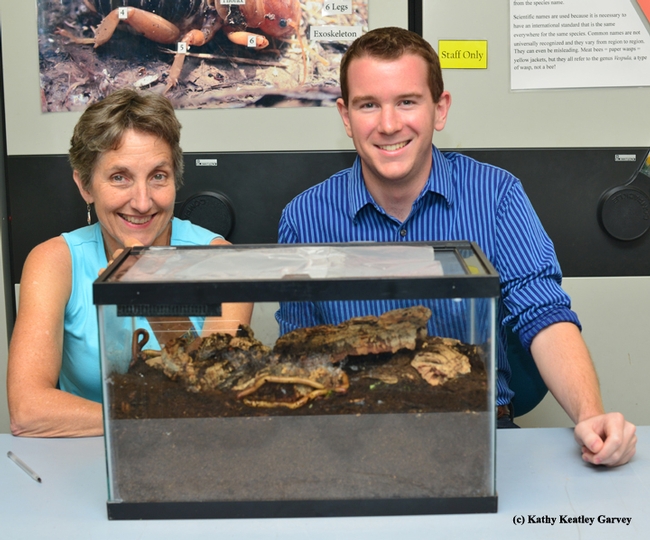
Mark your calendar.
The Bohart Museum of Entomology on the UC Davis campus is planning an open house on "How to Be an Entomologist" from 1 to 4 p.m., Saturday, Sept. 27. The insect museum is located in Room 1124 of the Academic Surge building, Crocker Lane, off LaRue Road.
The event is free and open to the public and is family friendly. This is the first of nine open houses during the 2014-15 academic year.
Plans call for a number of UC Davis entomologists to participate--to show and explain their work, said Bohart Museum director Lynn Kimsey, professor of entomology, UC Davis Department of Entomology and Nematology.
"We will have a pinning and butterfly and moth spreading ongoing workshop with Jeff Smith and tips on how to rear insects," said Tabatha Yang, the Bohart Museum's education and outreach coordinator. Smith, an entomologist in Sacramento, is a longtime donor and volunteer at the Bohart.
Representatives from the labs of molecular geneticist Joanna Chiu, assistant professor; bee scientist Brian Johnson, assistant professor; ant specialist Phil Ward, professor; insect demographer James R. Carey, distinguished professor; and integrated pest management specialist Frank Zalom, distinguished professor and current president of the 7000-member Entomological Society of America will share their research.
The Johnson lab will provide a bee observation hive, and Cindy Preto of the Zalom lab will be sharing her research on leafhoppers. The Carey lab will show student-produced videos, including how to make an insect collection, and one-minute entomology presentations (students showcasing an insect in one minute). The Ward lab will be involved in outside activities, demonstrating how to collect ants. Entomology students will be on hand to show visitors how to use collecting devices, including nets, pitfall traps and yellow pans.
Other entomologists may also participate. "There will be a lot going on inside the Bohart and outside the Bohart," Yang said. "It will be very hands-on."
The Bohart Museum, founded by noted entomologist Richard M. Bohart (1913-2007), houses a global collection of nearly eight million specimens and boasts the seventh largest insect collection in North America. It also houses the California Insect Survey, a storehouse of the insect biodiversity. The Bohart Museum's regular hours are from 9 a.m. to noon and 1 to 5 p.m. Mondays through Thursdays. The museum is closed to the public on Fridays and on major holidays. Admission is free.
The museum's gift shop (on location and online) includes T-shirts, sweatshirts, books, jewelry, insect-collecting equipment and insect-themed candy.
Special attractions include a “live” petting zoo, featuring Madagascar hissing cockroaches, walking sticks and tarantulas. Visitors are invited to hold the insects and photograph them. The newest residents of the petting zoo are Texas Gold-Banded millipedes, Orthoporus ornatus, which are native to many of the southwestern United States, including Texas.
“They're a great addition to the museum's petting zoo,” Kimsey said. “They are very gentle and great for demonstrations of how millipedes walk and how they differ from centipedes.”
Millipede enthusiast Evan White, who does design and communications for the Robert Mondavi Institute for Wine and Food Science, and is a frequent presenter at the Bohart's open houses, recently obtained the arthropods from a collector in Texas. “Texas Gold-Banded millipedes are naive to many of the Southwestern United States, not just Texas,” he said.
Contrary to popular belief, millipedes are not dangerous. “There is much public confusion about the difference between millipedes and centipedes--not because the two look similar, but because the terms are used interchangeably when not connected to a visual,” White said.
He described millipedes as non-venomous, and relatively slow moving, with cylindrical bodies, two pairs of legs per body segment, and herbivorous. “In fact, they are more like decomposers – they do well on rotting vegetation, wood, etc.--the scientific word for is ‘detritivore.' Most millipedes are toxic if consumed, some even secrete a type of cyanide when distressed. The point being: don't lick one.”
In contract, centipedes are venomous, fast-moving insects with large, formidable fangs, and one pair of legs per body segment. “They are highly carnivorous, although some will eat bananas. Go figure. And they are often high-strung and aggressive if provoked.”
Attached Images:

Lynn Kimsey, director of the Bohart Museum of Entomology, and millipede enthusiast Evan White, both of UC Davis, show Texas Gold-Banded mllipedes. (Photo by Kathy Keatley Garvey)

Close-up shot of Texas Gold-Banded millipedes. Millipedes are arthropods. (Photo by Kathy Keatley Garvey)

The Bohart Museum is home to nearly eight million insect specimens. (Photo by Kathy Keatley Garvey)